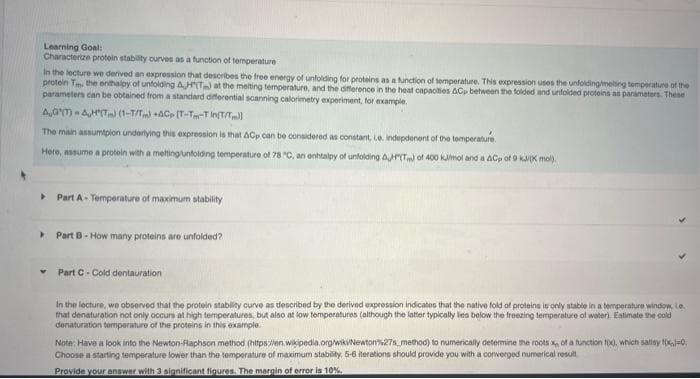Part C-Cold dentauration In the lecture, we observed that the protein stability curve as described by the derived expression indicates that the native told of proteins is only stable in a temperature window, Le that denaturation not only occurs at high temperatures, but also at low temperatures (although the latter typically lies below the freezing temperature of water). Estimate the cold denaturation temperature of the proteins in this example. Note: Have a look into the Newton-Raphson method (https://en.wikipedia.org/wiki/Newton270 method) to numerically determine the roots x, of a function f(x), which satisy f(x)=0. Choose a starting temperature lower than the temperature of maximum stability. 5-6 iterations should provide you with a converged numerical result Provide your answer with 3 significant figures. The margin of error is 10%
Part C-Cold dentauration In the lecture, we observed that the protein stability curve as described by the derived expression indicates that the native told of proteins is only stable in a temperature window, Le that denaturation not only occurs at high temperatures, but also at low temperatures (although the latter typically lies below the freezing temperature of water). Estimate the cold denaturation temperature of the proteins in this example. Note: Have a look into the Newton-Raphson method (https://en.wikipedia.org/wiki/Newton270 method) to numerically determine the roots x, of a function f(x), which satisy f(x)=0. Choose a starting temperature lower than the temperature of maximum stability. 5-6 iterations should provide you with a converged numerical result Provide your answer with 3 significant figures. The margin of error is 10%
Biochemistry
6th Edition
ISBN:9781305577206
Author:Reginald H. Garrett, Charles M. Grisham
Publisher:Reginald H. Garrett, Charles M. Grisham
Chapter31: Completing The Protein Life Cycle: Folding, Processing, And Degradation
Section: Chapter Questions
Problem 3P: Understanding the Relevance of Chaperones in Protein Folding Protein molecules, like all molecules,...
Related questions
Question
hello! i need help with C please! I ALREADY HAVE A AND B!! A was 36.3 C and B was 79.7 protiens out of 1 million.

Transcribed Image Text:Part C- Cold dentauration
In the lecture, we observed that the protein stability curve as described by the derived expression indicates that the native told of proteins is only stable in a temperature window, Le
that denaturation not only occurs at high temperatures, but also at low temperatures (although the latter typically lies below the freezing temperature of water). Estimate the cold
denaturation temperature of the proteins in this example.
Note: Have a look into the Newton-Raphson method (https://en.wikipedia.org/wiki/Newton%27s_ method) to numerically determine the roots x, of a function fox), which satisy f(x)=0.
Choose a starting temperature lower than the temperature of maximum stability. 5-6 iterations should provide you with a converged numerical result
Provide your answer with 3 significant figures. The margin of error is 10%
IVE ΑΣΦΑ
Toold=
Submit Request Answer
?
C

Transcribed Image Text:Learning Goal:
Characterize protein stability curves as a function of temperature
In the lecture we derived an expression that describes the free energy of unfolding for proteins as a function of temperature. This expression uses the unfolding/melting temperature of the
protein Tm the enthalpy of unfolding AH(T) at the melting temperature, and the difference in the heat capacities ACp between the folded and unfolded proteins as parameters. These i
parameters can be obtained from a standard differential scanning calorimetry experiment, for example.
4,0T)-A,H(Tm) (1-T/Tm) +ACp (T-Tm-Tin(T/Tm)))
The main assumpion underlying this expression is that ACp can be considered as constant, Le. indepdenent of the temperature.
Here, assume a protein with a melting/unfolding temperature of 78 "C, an enhtalpy of unfolding AH(Tm) of 400 kJ/mol and a ACp of 9 kJ/K mol).
▸ Part A - Temperature of maximum stability
▸ Part B - How many proteins are unfolded?
Y
Part C-Cold dentauration
In the lecture, we observed that the protein stability curve as described by the derived expression indicates that the native fold of proteins is only stable in a temperature window, Le
that denaturation not only occurs at high temperatures, but also at low temperatures (although the latter typically lies below the freezing temperature of water). Estimate the cold
denaturation temperature of the proteins in this example.
Note: Have a look into the Newton-Raphson method (https://en.wikipedia.org/wiki/Newton%27s_method) to numerically determine the roots x of a function to), which satisy 1-0.
Choose a starting temperature lower than the temperature of maximum stability. 5-6 iterations should provide you with a converged numerical result
Provide your answer with 3 significant figures. The margin of error is 10%.
Expert Solution
This question has been solved!
Explore an expertly crafted, step-by-step solution for a thorough understanding of key concepts.
This is a popular solution!
Trending now
This is a popular solution!
Step by step
Solved in 3 steps

Recommended textbooks for you

Biochemistry
Biochemistry
ISBN:
9781305577206
Author:
Reginald H. Garrett, Charles M. Grisham
Publisher:
Cengage Learning

Biology: The Dynamic Science (MindTap Course List)
Biology
ISBN:
9781305389892
Author:
Peter J. Russell, Paul E. Hertz, Beverly McMillan
Publisher:
Cengage Learning

Biochemistry
Biochemistry
ISBN:
9781305577206
Author:
Reginald H. Garrett, Charles M. Grisham
Publisher:
Cengage Learning

Biology: The Dynamic Science (MindTap Course List)
Biology
ISBN:
9781305389892
Author:
Peter J. Russell, Paul E. Hertz, Beverly McMillan
Publisher:
Cengage Learning